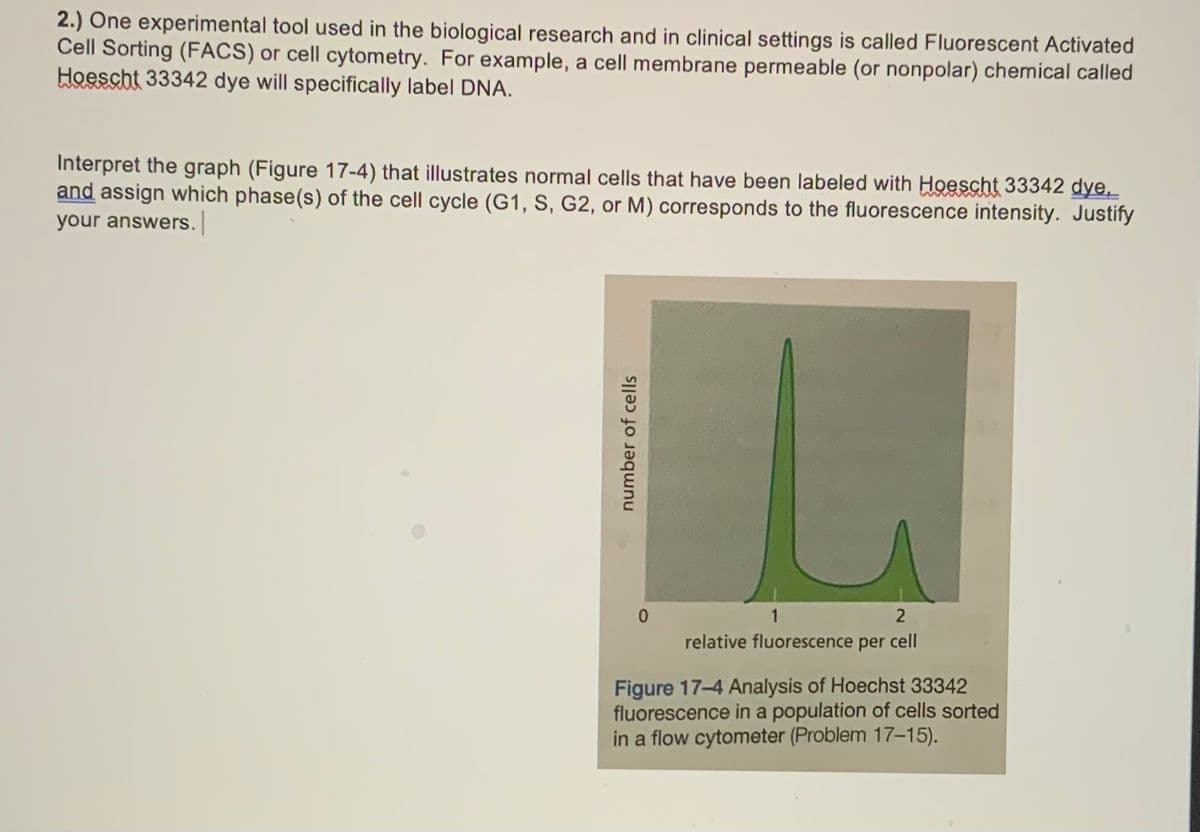2.) One experimental tool used in the biological research and in clinical settings is called Fluorescent Activated Cell Sorting (FACS) or cell cytometry. For example, a cell membrane permeable (or nonpolar) chemical called Hoescht 33342 dye will specifically label DNA. Interpret the graph (Figure 17-4) that illustrates normal cells that have been labeled with Hoescht 33342 dye. and assign which phase(s) of the cell cycle (G1, S, G2, or M) corresponds to the fluorescence intensity. Justify your answers. relative fluorescence per cell Figure 17-4 Analysis of Hoechst 33342 fluorescence in a population of cells sorted in a flow cytometer (Problem 17-15). number of cells
2.) One experimental tool used in the biological research and in clinical settings is called Fluorescent Activated Cell Sorting (FACS) or cell cytometry. For example, a cell membrane permeable (or nonpolar) chemical called Hoescht 33342 dye will specifically label DNA. Interpret the graph (Figure 17-4) that illustrates normal cells that have been labeled with Hoescht 33342 dye. and assign which phase(s) of the cell cycle (G1, S, G2, or M) corresponds to the fluorescence intensity. Justify your answers. relative fluorescence per cell Figure 17-4 Analysis of Hoechst 33342 fluorescence in a population of cells sorted in a flow cytometer (Problem 17-15). number of cells
Biochemistry
6th Edition
ISBN:9781305577206
Author:Reginald H. Garrett, Charles M. Grisham
Publisher:Reginald H. Garrett, Charles M. Grisham
Chapter28: Dna Metabolism: Replication, Recombination, And Repair
Section: Chapter Questions
Problem 19P: Figure 28.11 depicts the eukaryotic cell cycle. Many cell types “exit� the cell cycle and...
Related questions
Question

Transcribed Image Text:2.) One experimental tool used in the biological research and in clinical settings is called Fluorescent Activated
Cell Sorting (FACS) or cell cytometry. For example, a cell membrane permeable (or nonpolar) chemical called
Hoescht 33342 dye will specifically label DNA.
Interpret the graph (Figure 17-4) that illustrates normal cells that have been labeled with Hoescht 33342 dye,
and assign which phase(s) of the cell cycle (G1, S, G2, or M) corresponds to the fluorescence intensity. Justify
your answers.
1
relative fluorescence per cell
Figure 17-4 Analysis of Hoechst 33342
fluorescence in a population of cells sorted
in a flow cytometer (Problem 17-15).
number of cells
Expert Solution
This question has been solved!
Explore an expertly crafted, step-by-step solution for a thorough understanding of key concepts.
This is a popular solution!
Trending now
This is a popular solution!
Step by step
Solved in 2 steps

Knowledge Booster
Learn more about
Need a deep-dive on the concept behind this application? Look no further. Learn more about this topic, biology and related others by exploring similar questions and additional content below.Recommended textbooks for you

Biochemistry
Biochemistry
ISBN:
9781305577206
Author:
Reginald H. Garrett, Charles M. Grisham
Publisher:
Cengage Learning

Biology: The Dynamic Science (MindTap Course List)
Biology
ISBN:
9781305389892
Author:
Peter J. Russell, Paul E. Hertz, Beverly McMillan
Publisher:
Cengage Learning

Biology (MindTap Course List)
Biology
ISBN:
9781337392938
Author:
Eldra Solomon, Charles Martin, Diana W. Martin, Linda R. Berg
Publisher:
Cengage Learning

Biochemistry
Biochemistry
ISBN:
9781305577206
Author:
Reginald H. Garrett, Charles M. Grisham
Publisher:
Cengage Learning

Biology: The Dynamic Science (MindTap Course List)
Biology
ISBN:
9781305389892
Author:
Peter J. Russell, Paul E. Hertz, Beverly McMillan
Publisher:
Cengage Learning

Biology (MindTap Course List)
Biology
ISBN:
9781337392938
Author:
Eldra Solomon, Charles Martin, Diana W. Martin, Linda R. Berg
Publisher:
Cengage Learning

Biology 2e
Biology
ISBN:
9781947172517
Author:
Matthew Douglas, Jung Choi, Mary Ann Clark
Publisher:
OpenStax

Biology: The Unity and Diversity of Life (MindTap…
Biology
ISBN:
9781337408332
Author:
Cecie Starr, Ralph Taggart, Christine Evers, Lisa Starr
Publisher:
Cengage Learning

Biology: The Unity and Diversity of Life (MindTap…
Biology
ISBN:
9781305073951
Author:
Cecie Starr, Ralph Taggart, Christine Evers, Lisa Starr
Publisher:
Cengage Learning